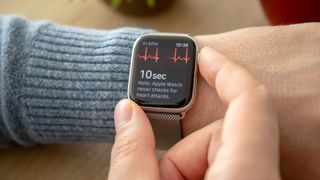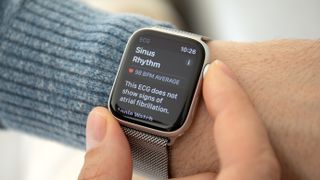How to use the ECG app on your Apple Watch
Give your heart a regular check-up

Since its launch in 2015, the Apple Watch has steadily evolved into device focused primarily on health – including that of your heart.
The wearable is currently on its sixth iteration; the Apple Watch 6 was released back in October 2020, with its new blood oxygen sensor and brand new colours. However, you don't need the latest model to check on your heart health. Since 2018 the Watch has been able to measure your heart rate with its electrocardiogram (ECG) sensor.
When you rest a finger on the crown of the Apple Watch, this and the sensor at the bottom of the Watch will both accurately measure your heart rate and when done, it will give you an overview of your heart rate while classing it as a sinus rhythm or atrial fibrillation (AF).
While this can be done manually, the sensor at the bottom of the Watch regularly checks your heart rate throughout the day, and if it measures a very high or very low reading, a notification shows on the Watch. It’s a very helpful feature, proven to save lives thanks to its accuracy.
However, you may be unaware of the ECG app itself, and how you can easily access it without being reminded through a notification.
Here’s an overview of what ECG means for the wearable, and which models of the Apple Watch support this useful feature.
Apple Watch models that support ECG
Since 2018, the Apple Watch has been able to give an ECG report from its Series 4 models and above.
Get daily insight, inspiration and deals in your inbox
Get the hottest deals available in your inbox plus news, reviews, opinion, analysis and more from the TechRadar team.
Currently the Apple Watch SE, released last year is the only model that Apple offers without an ECG feature.
How to use it
You can find whether ECG is available in your country on Apple's website. Make sure that both your Watch and iPhone has been updated to the latest versions of watchOS and iOS respectively, and go to the Health app on your iPhone.
This app gives you a detailed overview of not only your heart, but your walking, hearing, sleep and much more.
Go to the ‘Browse’ tab, navigate to ‘Heart’ and select ‘Electrocardiogram (ECG)’. Once the instructions are followed, you will then be able to access the ECG feature by going to the ECG app on the Watch.
It can also be used as a ‘complication’ on a watch face, so it’s much easier to access instead of going to the home screen, but either way, you will be prompted to hold your finger onto the Watch’s Digital Crown. After 30 seconds, a classification will appear.

What the different results mean
If your result is 'sinus rhythm', the ECG sensor has detected a normal pattern and there's no need to take action.
If the result keeps coming back as ‘Inconclusive’, it could be because of the Digital Crown or finger being recently exposed to liquid, which could distort the sensor. Make sure to clean and dry both before you try a reading again.
However, if you have received readings that suggest an abnormal heart rhythm with atrial fibrillation, it’s recommended to see your Doctor and show them the readings from within the Heart app.
Atrial fibrillation occurs when electrical impulses fire from different places in the top chambers of the heart in a disorganised route. This causes the top chamber to twitch, known as fibrillation, which in turn causes an irregular heartbeat.
The British Heart Foundation has a great overview on atrial fibrillation, and recommends taking the following steps to reduce the risk:
- Don’t smoke
- Be physically active
- Eat healthy foods
- Lower alcohol intake
- Keep a healthy weight

When a reading is taken, it's stored inside the ‘Health’ app, so you can see your heart rate when you took the ECG, alongside any other readings that the Watch took throughout the day.
It should be noted that a low or high heart rate is usually nothing to worry about, especially if you’ve recently exercised or had alcohol. But it could also mean that it could be due to nervousness, stress, infection or anxiety.
You can set notifications to appear if the readings report a heart rate that’s higher or lower than a particular value. You can set these warnings by going to the Watch app, then selecting ‘Notifications’ and ‘Heart’.
Other wearables with ECG sensors
There are other wearables that offer the same ECG feature as the Apple Watch, albeit with varying degrees of accuracy. If you have an Android phone, you could look to the following alternatives:
While we should stress that the ECG app isn't 100% accurate, it’s still a fantastic feature for a wearable device that can help give you an early warning about potential problems, and provide your doctor with more information if needed.
- The best fitness trackers available today

Daryl had been freelancing for 3 years before joining TechRadar, now reporting on everything software-related. In his spare time, he's written a book, 'The Making of Tomb Raider'. His second book, '50 Years of Boss Fights', came out in June 2024, and has a newsletter, 'Springboard'. He's usually found playing games old and new on his Steam Deck and MacBook Pro. If you have a story about an updated app, one that's about to launch, or just anything Software-related, drop him a line.
